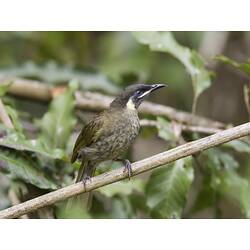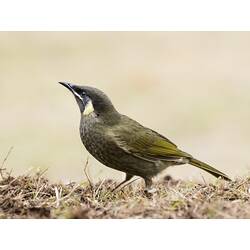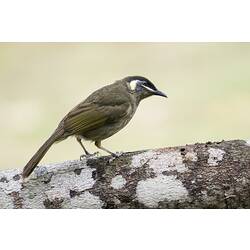General Description
A small to medium-sized bird, dark greenish grey in colour, with a creamy yellow gape (fleshy corners of the mouth). It has large, yellowish crescent-shaped ear patches. In flight, the pale yellow edges of the flight feathers can be seen. The bill is black and the eye is blue-grey. Both sexes are similar in appearance; juveniles are similar to the adults, but have brown eyes. Body size up to 22 cm.
Biology
It feeds mostly on fruits, favouring berries and small fruits, but also eats insects and nectar. Birds are normally seen alone, but may form loose groups of up to 10 birds. They feed in the upper branches and on the trunks of trees. Some insects are caught in flight. The strong 'machine gun'-like rattling notes of the call can be heard over long distances and reveal its presence in an area. The nest is a large cup of vegetation, bound together with spider web and lined with soft material. Little is known about parental roles in nest building and incubation, but both parents care for the young birds.
Distribution
Eastern Australia.
Habitat
Rainforest and wet sclerophyll forest, and adjacent dry sclerophyll forests and woodlands.
More Information
-
Animal Type
-
Animal SubType
-
Brief Id
Small to medium-sized bird, green grey colour, large crescent-shaped yellowish ear patches.
-
Colours
Green-grey
-
Maximum Size
22 cm
-
Habitats
-
Diet
Omnivore
-
Endemicity
-
Commercial
No
-
Conservation Statuses
CITES: Not listed, FFG Threatened List: Not listed, EPBC Act 1999: Not listed, IUCN Red List: Least Concern
-
Taxon Name
-
Common Name
Lewin's Honeyeater
-
Kingdom
-
Phylum
-
Subphylum
-
Class
-
Order
-
Family
-
Genus
-
Species Name
lewinii






